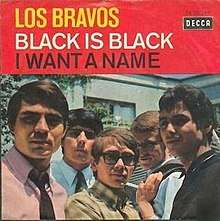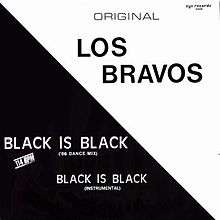Black Is Black
"Black Is Black" is a song by the Spanish rock band Los Bravos, released in 1966 as the group's debut single for Decca Records. Produced by Ivor Raymonde, the song reached number two in the UK,[1] number four in the U.S.,[2] and number one in Canada.[3] With the song's success, Los Bravos became the first Spanish rock band to have an international hit single.[4] A dance remix of the song was released as a single in 1986.
| "Black Is Black" | ||||
|---|---|---|---|---|
 | ||||
| Single by Los Bravos | ||||
| from the album Black Is Black | ||||
| Released | 1966 | |||
| Format | 7" single | |||
| Recorded | 1966 | |||
| Genre | Beat, psychedelic rock | |||
| Length | 2:59 | |||
| Label | Decca (UK) Press (US) | |||
| Songwriter(s) | Michelle Grainger, Tony Hayes, Steve Wadey | |||
| Producer(s) | Ivor Raymonde | |||
| Los Bravos singles chronology | ||||
| ||||
| Black Is Black ('86 Dance Mix) | ||||
 | ||||
Background
Four members of Los Bravos — bassist Miguel Vicens Danus, guitarist Tony Martinez, organist Manuel Fernandez, and drummer Pablo Sanllehi —had previously worked together in the Spanish band Los Sonors.[5] Together with German-born singer Michael Kogel, the group set out to achieve success in the European market making English-language pop music.[5] After signing with the Spanish division of Decca Records, the band went to England to work with Ivor Raymonde, a British producer, arranger, conductor, and composer who had been involved in making UK hit songs with such artists as Marty Wilde, Billy Fury, and Dave Berry.[5] "Black Is Black" was released in 1966 as the band's first Decca single.[5]
Reception
Lead singer Mike Kogel's vocals sounded so similar to Gene Pitney that many listeners assumed that "Black Is Black" was a Pitney single.[6][7] In August 1966, the song debuted at number 100 on the U.S. Billboard Hot 100 singles chart.[8] It peaked at number four in October,[9] and spent 12 weeks on the chart.[2] The song reached number one on the Canadian Singles Chart,[3] and peaked at number two in the UK Singles Chart.[1] The single also sold two million copies in Spain.[10]
Shortly after the September 11, 2001 attacks, American media conglomerate company Clear Channel Communications distributed the 2001 Clear Channel memorandum to program directors at the more than 1000 radio stations the company owned.[11] The memo contained a list of 162 songs with "questionable lyrics" that the stations should avoid playing.[11] "Black Is Black" was among the songs on the list.[11]
Johnny Hallyday version (in French)
A French version of the song, entitled "Noir c'est noir," was recorded by Johnny Hallyday and held the number one spot on France's singles chart for seven weeks in the fall of 1966.[12] It was covered as a single that same year by Canadian singer Renée Martel.[13] The song was also covered by French vocal trio La Belle Epoque and released as a 1976 single,[14] which peaked at number two in the UK,[15] and reached number one in Australia in October 1978. Australian-American singer Rick Springfield performed a version of the song on his 1982 album, Success Hasn't Spoiled Me Yet.[16] The track was also recorded in the same year (1976) in France by Cerrone and appeared on the B-side of his solo disco hit "Love in C Minor".[17]
Other versions
In 1967, Brazilian Jovem Guarda singer Jerry Adriani, stimulated from the success of Johnny Hallyday's version, recorded a Portuguese version written by Rossini Pinto, titled "Quem Não Quer". Also in 1967, Serbian rock band Siluete did a Serbian cover of the song. Two years later in 1969, Peruvian band Los Doltons released a version in Spanish. French female trio Belle Epoque released a disco remake of the song in 1977. In 1986, a dance remix of the original by Los Bravos was released as a single. Austrian pop band Joy released their version of the song as a single in 1987. In 1996, the song was covered by the Spanish pop/rock band La Unión on their album, Hiperespacio. Big Maybelle also recorded a version in the 1960s, and Jimmy Ruffin's debut album, The Jimmy Ruffin Way, featured a slow version of the song. In 2001, Los Straitjackets recorded a version with Raul Malo, lead singer of the Mavericks on the album Sing Along with Los Straitjackets. In 1976, Cerrone released his version as a single from his 3-track LP, Love in C Minor.
Track listing
- "Black Is Black" (Grainger, Hayes, Wadey) – 2:59
- "I Want a Name" (Diaz, Raymonde) – 2:38
Chart performance
Weekly charts
|
Year-end charts
|
La Belle Epoque version
|
|
References
- Roberts, David (2006). British Hit Singles & Albums (19th ed.). London: Guinness World Records Limited. p. 329. ISBN 1-904994-10-5.
- Whitburn, Joel (2007). Joel Whitburn's Billboard Top Pop Singles 1955-2006 (11th ed.). Menomonee Falls, Wisc.: Record Research. p. 69. ISBN 978-0-89820-172-7.
- "RPM 100". RPM. RPM Music Publications Ltd. 6 (7). 1966-10-10. Retrieved 2009-10-05.
- George-Warren, Holly; Romanowski, Patricia; Pareles, Jon (2001). The Rolling Stone Encyclopedia of Rock & Roll (3rd ed.). New York: Fireside Books (Simon & Schuster). p. 579. ISBN 0-7432-0120-5.
- Thomas, Bryan. "Black Is Black - Overview". Allmusic (Rovi Corporation). Retrieved 2009-10-06.
- "Los Bravos - Biography". Allmusic (Rovi Corporation). Retrieved 2009-10-05.
- Unterberger, Richie (1998). Unknown Legends of Rock 'n' Roll: Psychedelic Unknowns, Mad Geniuses, Punk Pioneers, Lo-Fi Mavericks & More. San Francisco: Backbeat Books. p. 207. ISBN 978-0-87930-792-9.
- "Billboard Hot 100". Billboard. Nielsen Business Media, Inc. 78 (33): 22. 1966-08-13. Retrieved 2009-10-06.
- "Billboard Hot 100". Billboard. Nielsen Business Media, Inc. 78 (40): 18. 1966-10-01. Retrieved 2009-10-06.
- "U.S.' Spanish Chart Inroads, Fall of Cover Cited by Milhaud". Billboard. Nielsen Business Media, Inc. 80 (42): 75. 1968-10-19. Retrieved 2009-10-05.
- Truitt, Eliza (2001-09-17). "It's the End of the World as Clear Channel Knows It". Slate (The Washington Post Company). Retrieved 2009-10-06.
- "Toutes les Chansons N° 1 des Années 60". Infodisc. Retrieved 2009-10-06.
- Renée Martel - Noir c'est noir (Black Is Black) at YouTube
- "La Belle Epoque – Black Is Black / Hey Miss Broadway at Discogs". Discogs. Retrieved 2012-04-23.
- "The Official Charts Company - La Belle Epoque - 'Black Is Black'". Official Charts Company. Retrieved 2009-10-05.
- "Success Hasn't Spoiled Me Yet - Overview". Allmusic (Rovi Corporation). Retrieved 2009-10-05.
- "Cerrone – Love In C Minor at Discogs". Discogs. Retrieved 2012-04-23.
- "Offiziellecharts.de – Los Bravos – Black Is Black". GfK Entertainment Charts. To see peak chart position, click "TITEL VON Los Bravos"
- "South African Rock Lists Website - SA Charts 1965 - 1989 Songs (A-B)".
- "Cash Box Top 100 10/01/66". Cashbox Magazine, Inc. Archived from the original on 2009-07-01. Retrieved 2009-10-06.
- The 100 Best-Selling Singles of 1966
- Cash Box Year-End Charts: Top 100 Pop Singles, December 24, 1966
- Kent, David (1993). Australian Chart Book 1970–1992. Australian Chart Book, St Ives, N.S.W. ISBN 0-646-11917-6.
- "Austriancharts.at – Belle Epoque – Black Is Black" (in German). Ö3 Austria Top 40.
- "Ultratop.be – Belle Epoque – Black Is Black" (in Dutch). Ultratop 50.
- http://www.infodisc.fr/Tubes_Artiste_Choisi.php
- https://www.ukmix.org/showthread.php?31984-Irish-Singles-Charts-1976-1978/page2
- http://www.hitparadeitalia.it/hp_yends/hpe1977.htm
- "Dutchcharts.nl – Belle Epoque – Black Is Black" (in Dutch). Single Top 100.
- "Charts.nz – Belle Epoque – Black Is Black". Top 40 Singles.
- "Norwegiancharts.com – Belle Epoque – Black Is Black". VG-lista.
- http://listadesuperventas.blogspot.com/2010/02/1977.html
- "Swisscharts.com – Belle Epoque – Black Is Black". Swiss Singles Chart.
- "Official Singles Chart Top 100". Official Charts Company. Retrieved 26 January 2014.
- Whitburn, Joel (2004). Joel Whitburn's Hot Dance/Disco 1974–2003. Menomonee Falls, Wisconsin, United States: Billboard/Record Research. p. 32. ISBN 0-89820-156-X.
- "Offiziellecharts.de – Belle Epoque – Black Is Black". GfK Entertainment Charts.
- Kent, David (1993). Australian Chart Book 1970-1992. St Ives, N.S.W.: Australian Chart Book. ISBN 0-646-11917-6.